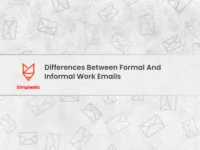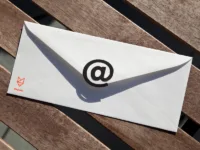Mastering the art of etiquette rules for writing professional correspondence correspondence is crucial for effective communication in any business setting. In professional emails and letters, maintaining a courteous and formal tone can help convey respect and attention to detail. Clear and concise writing ensures your message is easily understood, leaving a positive impression on your colleagues and clients.
To craft an effective email or letter, it’s essential to pay attention to the details, such as addressing the recipient correctly and choosing a precise subject line. These elements show that you value the recipient’s time and have considered their preferences. Remember, using proper etiquette in your correspondence not only reflects well on you as an individual but can also enhance the reputation of your organization.
In a world where digital communication is key, observing etiquette rules can set you apart. Crafting messages with professionalism and clarity will not only improve your communication skills but also help build trust and foster successful relationships in your workplace.
Etiquette rules for writing professional correspondence
Professional Correspondence
Professional correspondence is about communicating clearly and appropriately in a business setting. It ensures a strong impression and effective conveyance of information. Recognizing the various types of professional correspondence allows for tailored communication.
Definition and Importance
Professional correspondence refers to the communication that occurs between individuals in a business environment. This includes emails, letters, memos, and reports. The goal is to deliver messages effectively and maintain professionalism.
Communication should reflect your organization’s values and professionalism, impacting the way others perceive you and your company.
Proper correspondence can also strengthen relationships with clients and colleagues. It helps avoid misunderstandings, ensuring all parties involved are on the same page. By adhering to etiquette rules, you foster respect and clarity, crucial elements in professional settings.
Types of Professional Correspondence
There are several types of professional correspondence, each serving a unique purpose. Emails are the most common and used for quick exchanges. Make sure your email address is professional and the subject is clear.
Letters are typically more formal and used for official purposes like agreements or notices. Memos are often used internally to give information to teams or departments. Reports provide detailed information on specific topics, findings, or data analysis.
Selecting the right type ensures your message is perceived accurately and helps achieve your communication goals efficiently. Each type requires adherence to specific formats and tones, enhancing professionalism in your interactions.
Etiquette rules for writing professional correspondence
When crafting professional correspondence, it’s crucial to focus on being clear, maintaining an appropriate tone, and understanding the purpose and audience. These elements ensure the message is delivered effectively and maintains professionalism.
Basic Principles of Professional Writing
Clarity and Conciseness
Clear writing helps the reader understand your message without confusion. Use simple language and get straight to the point. Avoid jargon and overly complex sentences. Clarity means keeping your ideas straightforward.
Conciseness is about using the fewest words possible. Long-winded explanations can lose a reader’s interest. A concise email respects the reader’s time and increases the chance your message will be fully read. Create bullet points or numbered lists if you need to highlight key information. Each point should focus on a single idea to avoid confusion.
Tone and Formality
The tone of your writing sets the mood and helps convey your professionalism. A polite and professional tone makes your correspondence more effective. Avoid casual language in business settings, as it might seem unprofessional. Use greetings and closings that are more formal, like “Dear [Name]” and “Sincerely.”
Formality is determined by your relationship with the recipient. Writing to a colleague might allow for a slightly less formal tone than writing to a client. Pay attention to cultural differences that might impact tone and formality. Understanding these subtleties can enhance your credibility and effectiveness as a communicator.
Purpose and Audience Awareness
Knowing the purpose of your communication helps keep your writing focused. Every piece of correspondence should have a clear aim, whether it’s providing information, requesting a meeting, or following up on a project. Without a clearly defined purpose, messages can become muddled.
Being aware of your audience is essential. Tailor your language and level of detail to who you’re writing to. A message to a superior might be more detailed compared to a note to a peer. Identifying the needs of your audience helps in crafting messages that hit the mark and resonate well with them.
Structuring Your Message
When writing professional emails, effective structure is crucial for clarity and impact. Key areas to focus on include crafting strong subject lines, using appropriate greetings and closings, and organizing paragraphs logically.
Subject Lines and Headings
The subject line is the first thing a recipient sees in an email. Make it clear and concise. It should give a hint about the email’s content. Avoid being too vague or overly detailed. Consider keywords that are relevant to the reader and the purpose of the message.
Using headings in longer emails can help organize content. Headings guide the reader on what to expect in each section and make it easier to navigate the email, especially when covering multiple points.
Opening and Closing Remarks
Opening your email with a professional greeting sets the tone. Address the recipient appropriately, using their preferred name or title, like “Dr. Smith” or “Ms. Johnson.” If unsure, opt for a more formal title.
The closing should reflect professionalism, leaving a positive impression. Common closings include “Best regards” or “Sincerely.” Always include your name and contact information to ensure the recipient knows how to reach you. A polite thank you can also leave a good impression.
Paragraph Organization
Organizing your paragraphs helps the reader understand your message. Start with the main idea in the first sentence and provide supporting details in the following sentences. Keep paragraphs short and focused to maintain clarity.
Use bullets or numbered lists when presenting multiple points. This makes information easier to digest. Transitional phrases can also help connect ideas and maintain a smooth flow throughout the email.
Etiquette rules for writing professional correspondence
Email Etiquette
Understanding proper email etiquette can enhance your professional image. It’s crucial to address people correctly, structure the email body well, and manage attachments carefully.
Addressing Recipients
When addressing recipients, always use their preferred name and title. If unsure, choose a more formal option like “Mr.,” “Ms.,” or “Dr.” Avoid using slang or nicknames in professional settings. Opening with a proper salutation, such as “Dear” or “Hello,” sets a respectful tone.
Consider the context before choosing between a formal or informal approach. Additionally, use the last name unless otherwise instructed by the recipient. Paying attention to these details can significantly impact the recipient’s impression of you.
Email Body
Crafting the email body requires clarity and precision. Begin with a clear subject line that reflects the message. Avoid vague words like “Hi” or “FYI.” In the email body, get straight to the point without unnecessary details.
Use short paragraphs and bullet points when needed to make the email more readable. Maintain a professional tone and avoid casual language or humor. Ensure that important points are not buried under long blocks of text. Always proofread for grammatical errors before sending.
Attachments and Links
When including attachments, check that all relevant files are attached before hitting send. Clearly label each attachment so recipients know what to expect. Also, ensure the file size is manageable to avoid email delivery issues.
For links, use descriptive text instead of a raw URL. Ensure all links are working and direct to the intended content. Mention any attachments or links used in the body of the email so the recipient knows what to look for. Always be mindful of privacy and data sensitivity when sharing files or links.
Letter Writing Nuances
Writing a professional letter demands attention to small but significant details. Key elements include proper letter formatting, choosing the right salutations and closings, and understanding enclosures and carbon copies.
Letter Formatting
Proper formatting creates a polished and professional look. Start with your address at the top, right-aligned, followed by the date. The recipient’s address should be left-aligned below the date. Use a clear and readable font, such as Times New Roman or Arial, typically in size 12.
Maintain consistent margins, usually one inch on all sides. Use single line spacing with a double space between paragraphs. Include a subject line if necessary to clarify the purpose. Avoid using unnecessary graphics or colors that can distract from your message.
Salutations and Closings
Choosing the right salutation sets the tone for your letter. Use “Dear” followed by an appropriate title and last name, like “Dr. Smith” or “Ms. Johnson.” If the recipient’s name is unknown, default to a general salutation such as “Dear Sir or Madam.”
Closing the letter correctly is equally crucial. Sign off with “Yours sincerely” if the recipient is addressed by name. If you use a general salutation, end with “Yours faithfully.” Leave space for your signature between the closing and your typed name. A well-chosen closing conveys respect and professionalism.
Enclosures and CC/BCC Fields
When including additional documents, note them with “Enclosure” or “Enc.” after your signature. Specify the number and nature of enclosures to help the recipient find them easily. For example: “Enclosure: Resume, References.”
Using CC (carbon copy) and BCC (blind carbon copy) fields distributes your letter to additional recipients. CC is visible to all, suitable for transparency in business interactions. Use BCC to keep recipients concealed from each other, protecting privacy in bulk communications. Be mindful of confidentiality and the necessity of sharing content beyond the main recipient.
Cultural Sensitivity in Correspondence
Effective professional correspondence requires being aware of and sensitive to cultural differences. To build positive relationships and avoid misunderstandings, adapting your communication style is essential.
Understanding Cultural Differences
Cultural differences can significantly impact how messages are perceived. It’s important to be aware of variations in formality, tone, and even the expectations of timing in responses. In some cultures, addressing someone by their first name may be seen as too informal, while in others, it’s perfectly acceptable. Formal titles like Mr., Mrs., or Dr. might be customary in certain regions. Similarly, the preferred style of greetings, such as a handshake, a bow, or no physical contact, may vary widely.
When communicating across cultures, researching the cultural norms and etiquette of your contact’s country can prevent missteps. For example, in Japan, business cards are a key part of corporate interactions, so respecting the formal exchange process is important. Simple gestures like acknowledging public holidays or festivals in your correspondence can also foster goodwill.
Adapting Communication Styles
To communicate effectively with someone from a different culture, adapt your style to fit the other’s preferences. Notice the recipient’s communication style and mirror it to some extent. If they use formal language, follow suit. Conversely, if they communicate more informally, you might choose to relax your tone slightly.
Avoid slang and idiomatic expressions, as these can often be misunderstood or misinterpreted. Being clear and straightforward helps ensure your message is correctly perceived. Pay attention to non-verbal cues in video calls or face-to-face meetings, as they can provide insights into how the other person feels about the interaction.
Modifying your communication approach with some consideration and empathy can make your correspondence more effective and respectful. It shows that you value and respect the diversity of your business relationships. Keep cultural nuances in mind to facilitate better international communication.
Handling Sensitive Topics
When writing emails about sensitive subjects, it is important to be clear, considerate, and timely. These emails often require extra care to maintain professionalism and trust.
Delivering Bad News
Delivering bad news through email should be done with empathy and clarity. Start by acknowledging the situation directly but sensitively. Avoid using overly complex language or downplaying the issue. Explain the reasons behind the decision or event clearly. Offer supportive solutions or alternatives when possible. Be empathetic and express regret where appropriate, but avoid sounding insincere. It’s important to allow the recipient space to process the information, so avoid pushing for immediate responses unless necessary.
Negotiations and Requests
When you’re negotiating or making requests, remain polite and clear. Start by clarifying your goals and what you hope to achieve. Use clear language to explain your needs. Provide relevant details and context to support your position or request. Be open to feedback and willing to compromise. Use positive language to build goodwill and maintain a professional tone. Such emails should be direct, yet mindful, making sure you address potential concerns or hesitations the recipient might have. In closing, express appreciation for their time and consideration.
Timing of Emails
The timing of your email can greatly impact its reception. Avoid sending sensitive emails late at night or over the weekend, unless it’s urgent. This gives the recipient time to read and respond thoughtfully. Consider the recipient’s time zone and work schedule, especially if you’re in different locations. Sending emails during business hours is typically best, ensuring they are read and dealt with promptly. Think carefully about timing with respect to context—sending a challenging request at the end of a stressful day may not yield the best response.
Revisions and Proofreading
Ensuring your professional correspondence is polished involves careful attention to detail. This includes checking grammar and spelling, as well as seeking feedback and conducting a thorough final review. Following these steps can significantly improve the quality of your communication.
Grammar and Spelling
It is important to check your work for grammar and spelling errors. These mistakes can undermine your professionalism and cause misunderstandings. Use tools like spell checkers or apps such as Grammarly to catch errors you might miss.
Read through the text slowly, focusing on each sentence. Look for common errors like incorrect word choices, subject-verb disagreement, and punctuation mistakes. Fix typographical errors, such as misspelled words and misplaced commas.
When proofreading, it helps to read the document aloud. This can help you notice awkward phrases and repeated words. Make sure everything is consistent with your usual writing style.
Feedback and Final Review
Before sending important emails, consider getting feedback from peers or colleagues. A fresh pair of eyes can catch errors you might have overlooked and suggest improvements to your wording and tone. If possible, have someone familiar with the topic review your work.
After incorporating feedback, do a final review yourself. This involves reading the email one last time to ensure it is clear and to the point. Make sure all names and titles are correct. Confirm the message is properly formatted and free from unnecessary jargon.




